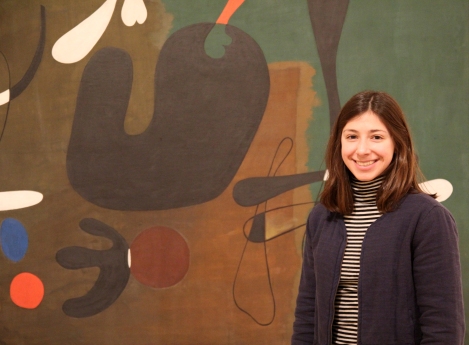 Many times throughout this semester I’ve caught myself thinking that participating in the Teaching in the Galleries program was one of the best decisions I’ve made so far in my short experience as a Washington University student. I feel unbelievably lucky to have found out about this opportunity and been given the privilege of participating in it. Attending docent meetings was one of the highlights of my week, every week. It gave me the chance to explore topics in education, art history, the museum industry, and public art in a deep and engaging way. In addition, the docents-in-training and Amy [Miller, assistant educator] became a community. This program lies at a perfect nexus between the social aspect of co-curriculars and the intellectualism of a class.
Many times throughout this semester I’ve caught myself thinking that participating in the Teaching in the Galleries program was one of the best decisions I’ve made so far in my short experience as a Washington University student. I feel unbelievably lucky to have found out about this opportunity and been given the privilege of participating in it. Attending docent meetings was one of the highlights of my week, every week. It gave me the chance to explore topics in education, art history, the museum industry, and public art in a deep and engaging way. In addition, the docents-in-training and Amy [Miller, assistant educator] became a community. This program lies at a perfect nexus between the social aspect of co-curriculars and the intellectualism of a class.
This experience gave me the space to develop many academic skills and explore my interests in an informal setting. It has been a space to practice and refine my abilities in public speaking and communication, which I’ve already found beneficial outside of museum education. I attribute much of my success in my art history course this semester to the visual analysis techniques like Visual Thinking Strategies and the deep value placed on close looking that I learned as a docent. I loved the content the program covered and the way it was approached. The readings were manageable, and the questions facilitated discussion. I thought the meeting structure was a perfect mix of teaching pedagogy, museum theory, and practice and observation. While the semester was front-loaded in terms of work and the timeline of preparing for our first tour, ultimately this quick schedule was more immersive than overwhelming. Also the decrease in work as the semester wound down continued to ensure that my docent training didn’t impact my other courses.
Beginning this program at the Kemper so soon after arriving at Wash U definitely helped me feel established and accomplished right away. I applied to this program largely on a whim with very few expectations, so I was pleasantly surprised to discover my genuine passion for museum education through this experience. I feel confident that my participation in Teaching in the Galleries has made me a more competitive applicant to programs I’m applying to (like the summer internships at the Contemporary Art Museum St. Louis). Also, this program has opened the possibility of a career in museum administration or education to me. I had no idea that there were so many interesting ways to work in public art spaces or that I would find this field so interesting.
One of the single greatest things this program has given me is a greater comfort at Wash U and in St. Louis. As a docent at the Kemper I feel more integrated in the Sam Fox School community and, by extension, Washington University as a whole. Our trips to the museums around the city have opened my eyes to the interesting places off campus and provided me with valuable opportunities to explore and engage in my new environment. I’ve since dragged many of my friends around St. Louis to share these wonderful public art spaces with them. It was an enlightening and unique experience to compare the educational approaches of the Contemporary Art Museum, Saint Louis Art Museum, Pulitzer Arts Foundation, and the Kemper. I think this specific aspect of the docent training program contextualized the theories we were reading about and gave me a better understanding of my role as a museum educator by allowing me to compare the different approaches firsthand.
Through the readings and experiences in this program, I’ve come to see the role of museum education as much broader than what I previously experienced. Before Teaching in the Galleries, I was the kind of museum-goer who always declined a docent-led tour in favor of greater “independence” and read all the wall panels. Now I realize I missed out on the great experience to have a more personal, intellectual, and aesthetic experience with art. I think the role of museum education is to make artwork accessible and alive to the public—to give people the chance to form their own opinions and have a reflective and personal experience. An engaging tour can provide a museum visitor with tools of visual analysis, powerful means of interpretation, and a guide to lead them toward an emotional encounter with art. I think explicit museum education efforts, like docents and programs that make the space more accessible, are crucial elements of museum education. Museums should be public and alive, just like the art they house.
Through this program, I’ve found a new passion for museum education. I already loved museums and art and had experienced the thrill of teaching, but combining these two interests has been incredibly gratifying. I am excited to spend the next four years as a student docent at the Kemper. I also can’t wait to see where this opportunity and new passion will lead. Hopefully, I can remain engaged in museum education through internships and volunteering for a long time. I honestly can’t say enough great things about this experience. Being a docent has given the amazing ability to spread the personal joy I derive from visiting an art museum to others.
—Sofia Goodman BA19
